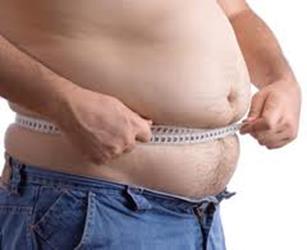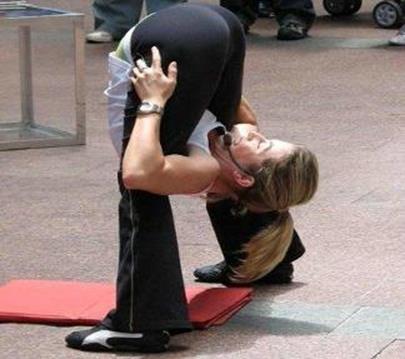




|
How does that little beer belly and being overweight affect your back and joints?
Have you ever tried to carry around 40 or 50 pounds in a backpack? Or carry a 90 pound bag of concrete? Or just a couple of heavy shopping bags? Then you know the answer, no matter what condition you are in, you feel the effects that carrying that extra weight has on your body. Now just imagine carrying it all the time…
The spine is a very delicate part of the body. The spinal discs act as shock absorbers and ensure that vibrations and jerks do not affect the spine. If one is obese, fat will press against each and every part of the spine. Not only will this affect the bones, it can also affect your nerves, which will get pressed as extra fat presses against the gaps between the vertebrae.
The extra pounds can cause an increase in back pain. First, extra weight shifts the body’s center of gravity, which may alter posture and mechanically create more strain on the load–bearing joints in the spine, such as the facet joints and disks. Being overweight puts extra pressure on your joints, especially those in your knees, hips, and lower back. Due to this added load, the cartilage, which pads and supports the joints slowly wears down resulting to osteoarthritis. In the long run, the harm done on the joint can be massive. This type of injury is lasting and irreversible.
Tendinitis, or swelling of the tendons, is also widespread among those who are overweight. Tendons can become irritated and inflamed, especially the Achilles tendon, which stretches from your calf to your heel from simple, everyday activities such as walking. Weight loss reduces the pressure on the joints and tendons and lessens injury. Weight loss also may reduce the pain and inflammation of osteoarthritis.
Also, if a person is overweight the excessive fat in the abdominal cavity increases the pressure inside it. This makes gastric acid go up into the esophagus. Weight loss can decrease gastro-esophageal reflux.
Another problem is that changes in systemic inflammation associated with obesity may make people more likely to experience pain. Obesity is linked to low levels of systemic inflammation, and this is thought to be one reason for the increased prevalence of osteoarthritis, periodontal disease and cardiovascular diseases associated with obesity. Therefore, people who are overweight may not only have increased stress on their joints but may also be more likely to feel pain.
Whether we are talking about the back or any of the joints in the body, what we are really referring to is the cartilage and the synovial lining of these joints. Cartilage makes for a smooth, frictionless surface that allows us to move with ease. If the cartilage is damaged (due to added stress from extra pounds) the joint surface is no longer smooth and frictionless, and this results in pain. The unfortunate fact is that once cartilage is damaged it cannot grow back.
Being overweight can lead to several medical disorders. If you weigh more than you should, you increase the rick of having the following:
· Hypertension (high blood pressure) · High cholesterol · Joint and knee problems · Joint replacement surgery · Gastro-intestinal problems · Degenerative disc disease · Spinal stenosis · Osteoporosis · Rheumatoid arthritis · Hernia · Ruptured disc · Heavy burden on the spine Unhealthy posture
Weight clearly has an effect on the development of arthritis. Research has shown that the incidence of knee arthritis is increased in individuals with a body mass index over 30 ("obese").
So What Can You Do?
One persistent myth regarding back and joint pain is that the joints and back require rest to reduce the pain. In fact, the opposite is true, and research supports the fact that the best thing you can do is to keep moving and keep exercising. Study after study show that bed rest is not indicated for back pain and that joint pain reduces with exercise and regular activity. Since motion can assist in weight loss, there is a strong rationale for remaining active despite experiencing this pain. Of course, pain that is severe or unrelenting may require the oversight of a health professional.
Another common myth is that exercise is going to make arthritis worse. Certainly, exercises that are painful should be avoided, and high–impact exercises place more mechanical stress on the joints, but most individuals with arthritis have improvement in their function with an exercise program.
Exercises that increase pain should be avoided or done in moderation. Sit–ups may stress the back unnecessarily. Try crunches instead. High–impact activities such as jumping, or beginning a running program if you’re not already accustomed to one, are best avoided. The great thing about exercise is that it doesn’t need to be fancy to be helpful. The key to avoiding back and joint pain and inflammation is that the exercise needs to occur regularly. It could be anything from simply walking to swimming to regular stretching
What are some key exercises and stretches available to reduce lower-back pain?
· Supine hollowing: Lie on your back with your knees bent and your feet flat on the floor. Perform a Kegel exercise, which is a contraction of the pelvic floor muscles (the same that you’d do to resist the urge to urinate). Exhale and contract your abdominal muscles, pushing your bellybutton to the floor and flattening your low back. Try to combine these two movements and hold for 15 seconds. Do this once. · Glute bridges: Lie on your back with your knees bent and your feet flat on the floor. Arms should be down by your sides for balance. Contract your glutes to push your hips up off of the floor, but not so high as to allow your back to arch. Slowly lower back down. Perform a set of 10. · Crunches: Lie on your back with your knees bent and your feet flat on the floor. Put your hands behind your head with your elbows wide. Exhale and raise your head and shoulders off the floor, pulling your rib cage to your pelvis. Hold briefly, then inhale as you lower back down. Do a set of 10. Plank: Lie on your stomach with your elbows close to your sides and directly under your shoulders, palms down and hands facing forward. Stiffen your torso and lift your abdomen off of the floor. Hold 15 – 30 seconds and slowly lower back down to the floor. Do this once. Stretches: · Knees to chest: Lie on your back with your head and neck relaxed. Bring your knees to your chest and hold that position for 10 – 30 seconds. Do this once. · Lower–trunk rotation: Lie on your back with your head and neck relaxed. Bring both knees to your chest. Without moving your shoulders or upper body, let your legs go toward the floor on one side. Hold for 10–30 seconds. Repeat on the other side. (Be sure to keep the opposite shoulder down on the ground.) Hamstring stretches: Sitting in a straddle position with your legs extended, bend and bring your chest forward toward the ground. Bend forward toward the middle, and then turn to lean toward each leg. Hold each position for 15–30 seconds |
|
Article published by Dr Finkle 4-2011 |





